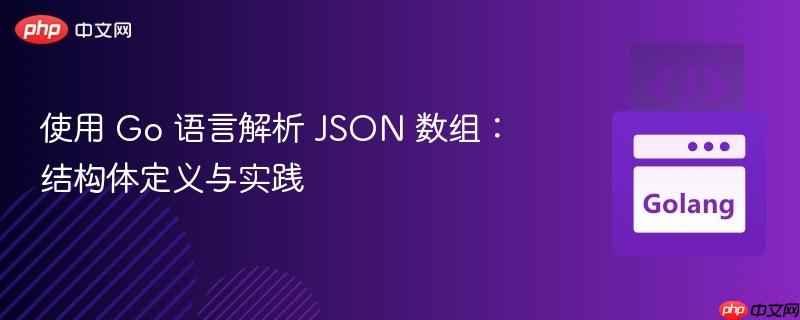
本文档旨在指导开发者如何使用 Go 语言的 `encoding/json` 包解析包含 JSON 数组的复杂 JSON 数据。我们将通过示例代码展示如何定义合适的结构体,以及如何使用 `json.Unmarshal` 函数将 JSON 数据映射到 Go 结构体中,从而方便地访问和处理数据。
在 Go 语言中,解析 JSON 数据是一项常见的任务,特别是当与 Web API 交互时。encoding/json 包提供了强大的功能,可以将 JSON 数据解码(Unmarshal)到 Go 结构体中。当 JSON 数据包含数组时,正确定义 Go 结构体至关重要。本文将通过示例详细介绍如何处理这种情况。
要正确解析 JSON 数据,首先需要定义与 JSON 结构相匹配的 Go 结构体。JSON 对象的每个字段都应在 Go 结构体中有一个对应的字段。对于 JSON 数组,Go 结构体中的对应字段应为切片(slice)。
考虑以下 JSON 示例:
{
"name": "example",
"options": [
{
"key": "a",
"value": "b"
},
{
"key": "c",
"value": "d"
},
{
"key": "e",
"value": "f"
}
]
}为了解析上述 JSON 数据,可以定义以下 Go 结构体:
type Option struct {
Key string `json:"key"`
Value string `json:"value"`
}
type Data struct {
Name string `json:"name"`
Options []Option `json:"options"`
}在这个例子中,Option 结构体用于表示 options 数组中的每个对象,而 Data 结构体包含一个 Name 字段(字符串类型)和一个 Options 字段(Option 结构体的切片)。 json:"key" 这样的 tag 用于指定 JSON 字段与 Go 结构体字段之间的映射关系。
定义好 Go 结构体后,就可以使用 json.Unmarshal 函数将 JSON 数据解析到结构体中。
package main
import (
"encoding/json"
"fmt"
"log"
)
type Option struct {
Key string `json:"key"`
Value string `json:"value"`
}
type Data struct {
Name string `json:"name"`
Options []Option `json:"options"`
}
func main() {
jsonData := []byte(`{
"name": "example",
"options": [
{
"key": "a",
"value": "b"
},
{
"key": "c",
"value": "d"
},
{
"key": "e",
"value": "f"
}
]
}`)
var data Data
err := json.Unmarshal(jsonData, &data)
if err != nil {
log.Fatalf("Error unmarshalling JSON: %v", err)
}
fmt.Printf("Name: %s\n", data.Name)
for _, option := range data.Options {
fmt.Printf("Key: %s, Value: %s\n", option.Key, option.Value)
}
}在这个例子中,jsonData 变量包含要解析的 JSON 数据。json.Unmarshal 函数接受两个参数:JSON 数据(字节切片)和一个指向要填充的结构体的指针。如果解析成功,data 变量将包含从 JSON 数据中提取的值。如果解析失败,err 变量将包含错误信息。
实际应用中,JSON 结构可能更复杂,包含多层嵌套的数组和对象。在这种情况下,需要相应地定义 Go 结构体,确保每个 JSON 字段都有对应的 Go 字段。
例如,考虑以下 JSON 结构:
{
"petfinder": {
"lastOffset": {
"$t": 5
},
"pets": {
"pet": [
{
"options": {
"option": [
{
"$t": "altered"
},
{
"$t": "hasShots"
},
{
"$t": "housebroken"
}
]
},
"breeds": {
"breed": {
"$t": "Dachshund"
}
}
},
{
"options": {
"option": {
"$t": "hasShots"
}
},
"breeds": {
"breed": {
"$t": "American Staffordshire Terrier"
}
},
"shelterPetId": {
"$t": "13-0164"
},
"status": {
"$t": "A"
},
"name": {
"$t": "HAUS"
}
}
]
}
}
}为了解析这种 JSON 结构,需要定义如下 Go 结构体:
type PetFinder struct {
LastOffset LastOffset `json:"lastOffset"`
Pets Pets `json:"pets"`
}
type LastOffset struct {
T int `json:"$t"`
}
type Pets struct {
Pet []Pet `json:"pet"`
}
type Pet struct {
Options Options `json:"options"`
Breeds Breeds `json:"breeds"`
ShelterPetId ShelterPetId `json:"shelterPetId,omitempty"`
Status Status `json:"status,omitempty"`
Name Name `json:"name,omitempty"`
}
type Options struct {
Option []OptionValue `json:"option"`
}
type OptionValue struct {
T string `json:"$t"`
}
type Breeds struct {
Breed BreedValue `json:"breed"`
}
type BreedValue struct {
T string `json:"$t"`
}
type ShelterPetId struct {
T string `json:"$t"`
}
type Status struct {
T string `json:"$t"`
}
type Name struct {
T string `json:"$t"`
}
请注意,这里使用了 omitempty tag,表示如果 JSON 中不存在对应的字段,则忽略该字段。
本文介绍了如何使用 Go 语言的 encoding/json 包解析包含 JSON 数组的 JSON 数据。通过定义与 JSON 结构匹配的 Go 结构体,并使用 json.Unmarshal 函数,可以方便地将 JSON 数据映射到 Go 结构体中,从而方便地访问和处理数据。在处理复杂的 JSON 结构时,需要仔细定义 Go 结构体,并注意错误处理。
以上就是使用 Go 语言解析 JSON 数组:结构体定义与实践的详细内容,更多请关注php中文网其它相关文章!

每个人都需要一台速度更快、更稳定的 PC。随着时间的推移,垃圾文件、旧注册表数据和不必要的后台进程会占用资源并降低性能。幸运的是,许多工具可以让 Windows 保持平稳运行。




Copyright 2014-2025 https://www.php.cn/ All Rights Reserved | php.cn | 湘ICP备2023035733号